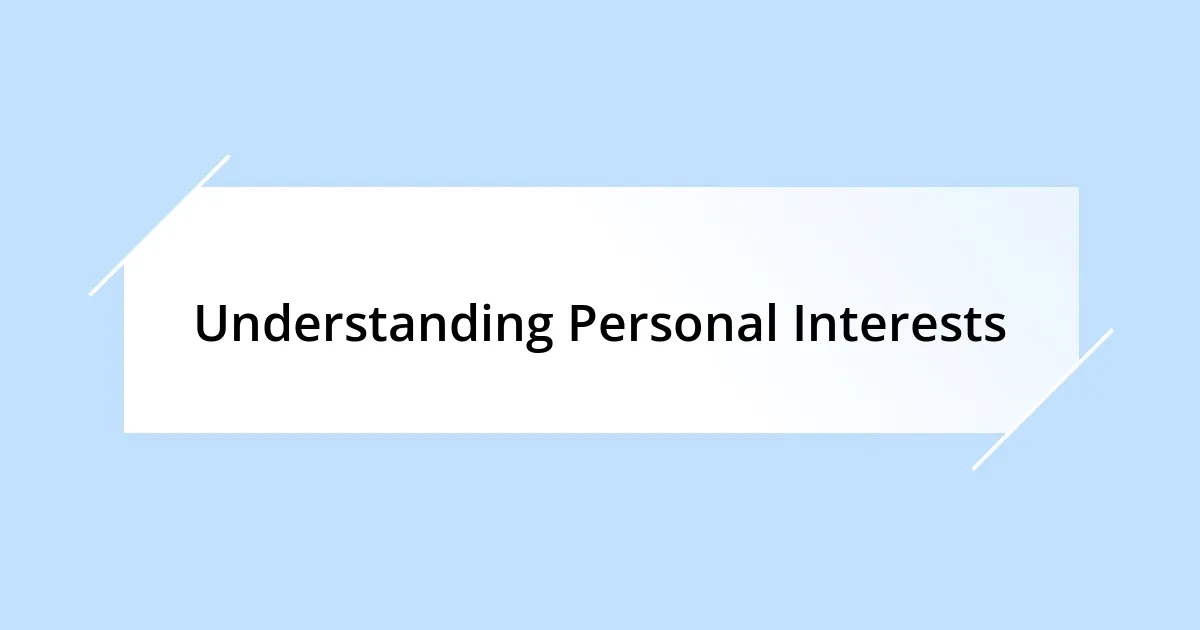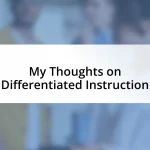Key takeaways:
- Understanding personal interests can lead to profound self-discovery and new passions.
- Identifying audience preferences through open-ended questions, surveys, and social media analysis enhances content creation.
- Utilizing storytelling techniques and vivid imagery makes content engaging, fostering emotional connections with the audience.
- Measuring engagement effectiveness through data and qualitative feedback is essential for refining content strategies.

Understanding Personal Interests
Understanding personal interests is like uncovering hidden treasures within yourself. I remember the first time I discovered my passion for photography at a local park; I felt an exhilarating rush as I captured the sunlight filtering through leaves. Don’t you think there’s a certain magic in realizing what truly makes your heart race?
Exploring personal interests involves diving deep into what resonates with us. I often reflect on how my love for cooking emerged from childhood memories spent in my grandmother’s kitchen, where flavors brought us together. Have you ever thought about how a simple experience could shape your lifelong passions?
Recognizing what sparks our curiosity can lead to profound self-discovery. For me, it was joining a book club that opened avenues to unexplored genres and ideas. What if the key to understanding yourself better lies in embracing those interests you’ve brushed aside? Exploring these avenues not only enriches our lives but often reveals new paths we didn’t even know existed.

Identifying Audience Preferences
Identifying audience preferences starts with genuine observation. I recall attending a workshop where the facilitator encouraged us to ask open-ended questions. By simply engaging participants in conversation about their favorite books and hobbies, I learned so much about the diverse interests within the group. Isn’t it fascinating how a few well-placed questions can reveal what really captivates people?
I’ve also found that conducting surveys can be a valuable tool in this process. Once, I sent out a quick online survey to friends and family asking about their preferred weekend activities. The responses surprised me; many valued experiences over material gifts. It made me realize that tapping into audience desires is often about understanding their values and what brings them joy.
In my experience, social media insights are golden when identifying preferences. I noticed that my posts about travel received far more engagement than those about cooking. By analyzing likes and comments, I could gauge what resonated with my audience. Isn’t it empowering to use this data to guide content creation?
| Method | Key Insight |
|---|---|
| Open-ended Questions | Reveals diverse interests |
| Surveys | Highlights values and priorities |
| Social Media Analysis | Indicates audience engagement |

Crafting Engaging Content

Crafting Engaging Content
Creating engaging content is all about weaving a narrative that resonates. I once wrote a blog post detailing my journey hiking through the stunning landscapes of the Pacific Northwest. Sharing my struggles and triumphs not only made the piece relatable but also sparked conversations with readers who had similar experiences. Isn’t it remarkable how stories can create connections among us?
To truly captivate an audience, I emphasize the importance of authenticity and relatability. Drawing from my own passions allows me to infuse my content with genuine emotion, making it feel less like information and more like a conversation with a friend. Here are some tips that have worked for me:
- Tell personal stories: Sharing your experiences can create an emotional bond.
- Use vivid imagery: Describing scenes in detail helps readers visualize and immerse themselves.
- Include humor: Don’t shy away from adding a light-hearted touch to keep things enjoyable.
- Engage the senses: Invoking sights, sounds, and smells can enhance the reading experience.
- Ask questions: Encourage readers to reflect and respond, creating a two-way dialogue.
Diving deep into these elements has proven invaluable in crafting content that not only informs but also inspires. What techniques do you find effective in capturing attention and sparking interest?

Utilizing Storytelling Techniques
Utilizing storytelling techniques can transform mundane content into something truly captivating. I remember a time when I shared a story about a road trip that went awry. As I navigated detours and unexpected challenges, readers weren’t just following my narrative; they were feeling the excitement and frustration alongside me. It’s interesting how sharing those imperfect moments invites the audience to connect personally. Have you ever noticed how a relatable mishap can make a story stick?
Vivid imagery plays a key role in storytelling. I can vividly recall a time when I described the crunch of autumn leaves underfoot during a nature walk. Readers told me they could almost hear that sound, which brought them back to their own outdoor experiences. By painting pictures with words, I’ve noticed that I can transport my audience to different places and moments, immersing them in the narrative. How often do you find yourself lost in a beautifully crafted description?
Moreover, the inclusion of emotions makes stories memorable. I once recounted a moment of vulnerability when I faced a big decision in my life. Sharing my fears and hopes resonated with many readers who reached out to share their journeys. It’s evident to me that when we allow ourselves to be open and honest, we create threads of connection. Don’t you think that vulnerability can be one of the strongest forms of engagement?

Incorporating Visual Elements
Visual elements are essential when crafting content that captures attention. I once experimented with incorporating infographics in a presentation about productivity hacks. The visual representation of data not only made complex information digestible but also attracted more interest from my audience. Have you ever noticed how a well-designed visual can convey a message more powerfully than words alone?
Images can evoke emotions that words sometimes can’t. I recall sharing a stunning sunset photo after a long hike, which resonated with many of my followers. The colors and the scene stirred feelings of peace and adventure, connecting with those who had similar experiences. It’s fascinating to think about how visual storytelling can create a shared emotional landscape, isn’t it?
Lastly, using videos has greatly enhanced my content engagement. I remember posting a short clip of me trying a new recipe, showcasing each step along the way. The dynamic nature of video not only made it fun to watch but also allowed me to connect with viewers as if we were cooking together in the same kitchen. I believe that incorporating such visuals can bridge the gap between creator and audience, making them feel like an integral part of the journey. How do you think visuals could enhance your own storytelling?

Measuring Engagement Effectiveness
Measuring the effectiveness of engagement strategies is essential for refining content. I remember one instance when I analyzed audience interactions after implementing a new approach to my blog. I noticed a significant uptick in comments and shares, signaling that my readers were truly resonating with the changes. Isn’t it incredible how data can unveil what our audience genuinely connects with?
Another critical aspect is tracking engagement metrics over time. I’ve often discovered that certain themes resonate at different times, like when a post about embracing failure garnered more attention during a time of global uncertainty. It made me appreciate that engagement isn’t just about the present moment; it’s about understanding the underlying currents that influence our audience’s reactions. Have you ever experienced a shift in engagement levels based on external factors?
Lastly, qualitative feedback from readers offers invaluable insights into engagement effectiveness. I recall receiving heartfelt messages from readers who shared how a particular story impacted their lives. These personal notes not only fueled my motivation but also highlighted the power of emotional connections in measuring engagement. Don’t you think that the stories behind the numbers can often reveal even more about our audience?

Adapting Strategies for Success
Adapting strategies for success requires a willingness to pivot based on what I learn from my audience. I once hosted a webinar that didn’t attract the number of participants I had hoped for. After reviewing feedback and adjusting the format to be more interactive, the next session saw double the attendees. Isn’t it amazing how small changes can lead to substantial shifts in engagement?
Flexibility is crucial when I implement new ideas. For instance, during a tough winter, I decided to launch a series on self-care practices. I noticed that the response was overwhelming; people were hungry for content that spoke to their emotional needs during dreary days. It made me realize how listening to the pulse of my audience can transform an ordinary strategy into a successful one. What kinds of adaptations have you made in your approach, driven by the needs of those you connect with?
Furthermore, integrating feedback loops has been transformative in my strategy development. I invite my audience to share their thoughts regularly through polls and open discussions. Recently, a reader suggested a topic about mental wellness that I had overlooked, which turned out to be one of my most shared pieces! This taught me that being responsive and open to suggestions not only fosters community but also leads to unexpected successes. Doesn’t it feel rewarding to allow your audience to steer the ship occasionally?














